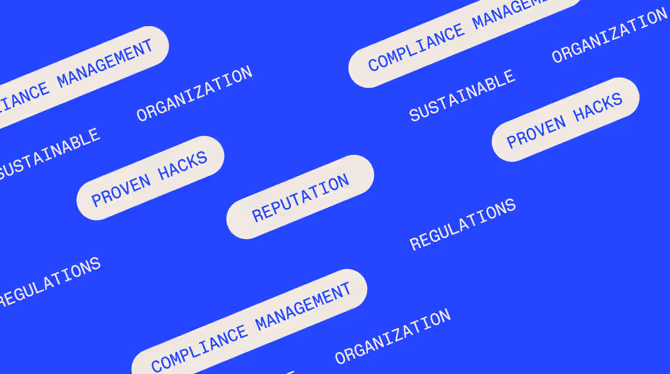Labor law compliance in the age of AI
%202.avif)
LEAD WITH CONFIDENCE
Streamline processes with our HR templates

AI offers workplaces countless new opportunities for efficiency. But before you go replacing your workforce with AI-powered robots, stop to consider labor law compliance.
You have a duty of care to your employees that trumps all other business and technological developments. AI technologies might be exciting, but it's important to understand employees’ rights and protections before adopting any new processes.
In this guide, we offer a breakdown of labor laws and compliance best practices and discuss how AI is having an impact.
Why employment law is important for companies to understand
Labor and employment laws are any international, national, or local regulations that outline your responsibilities to your employees. They include anti-discrimination rulings, payment and benefit regulations, workplace safety requirements, and much more. Compliance requires making sure teams across your organization adhere to these laws.
Labor laws protect three main groups:
- Employees: Employees are hired individuals who work under the direction of their employer. Employees generally receive the most protection from labor laws.
- Workers: Worker is a more general term than employee and covers a wider range of individuals, such as temporary workers and interns. Many labor laws that protect employees also extend to workers.
- Self-employed individuals: Although not as common, many labor laws also count self-employed workers when factoring in protections.
What is labor law compliance?:
While labor laws offer many protections, depending on the jurisdiction, there are six main areas of business employment law compliance:
- Minimum wage: Employees must receive at least the federal or state minimum wage.
- Overtime pay: Unless exempt, employees whose hours exceed the standard workweek must receive overtime pay.
- Working hours: Employees have a specific maximum number of hours they can work a week.
- Workplace safety: Workplaces must be safe and compliant with Occupational Health and Safety Administration (OSHA) regulations
- Anti-discrimination: Employees must not be discriminated against based on their age, gender, race, disability, or several other qualifiers.
- Employee benefits: Employees must receive state-mandated benefits, like retirement plan options and healthcare.
Employment compliance law: 5 elements of labor law
Many countries have radically different legal systems, but there are a few common threads that run through labor and employment law frameworks.
Here are five foundational elements of U.S. and Canadian labor law.
Employee rights and protections
Employee rights and protections are general safeguards of their well-being. They include employees’ rights to fair pay, to not be discriminated against, and to work in a safe environment.
Employee terms and conditions
Companies must provide an employment contract when they hire someone. This contract includes terms and conditions that lay out core details of the employer-employee relationship. Probationary periods, severance requirements, and essential duties should all be covered.
Employee benefits and compensation
Depending on the jurisdiction, employees are legally entitled to specific benefits. In the U.S., companies with 50 or more full-time employees are required to cover health insurance, for example.
Overtime pay, baseline wages, and paid leave are all commonly covered. The Family and Medical Leave Act also mandates that employees be allowed to take job-protected, unpaid leave for several specified family or medical-related reasons.
Collective labor rights
Collective labor laws afford workers rights beyond the workplace. For example, freedom of association is protected under the First Amendment, allowing workers to join or form labor unions. Similar laws define the conditions under which workers can strike and negotiate with their employers.
Special protections
Federal labor laws restrict or add conditions to the employment of certain protected groups. Examples include children being protected from work through child labor laws, disabled workers having the right to reasonable adjustments in the workplace, and pregnant workers being entitled to maternity leave.
How to comply with workplace employment law: 7 best practices
While there’s a lot to keep up with, compliance with workplace employment law doesn’t have to be a challenge.
Here are seven best practices to stay on top of obligations.
Post labor law notices in a conspicuous location
Remember, staff need to comply with labor laws, too. Employees should know about the rights of others and what constitutes a safe work environment. Post information about fair labor standards, anti-discrimination laws, and equal pay legislation to educate your workforce about their rights and responsibilities.
Stay updated and informed with a compliance plan
A compliance plan maps out all your responsibilities according to federal, global, and local regulations. It can be a handy way to build compliant processes while avoiding legal slip-ups.
Review policies and procedures
Legislation is slow to change, but so is internal policy. Keep track of employment and labor regulations to make sure you stay in line. After reviewing your responsibilities, check internal HR policies, scan existing procedures, and update workflows accordingly. Internal audits can identify any policy gaps.
Provide employee training
Innocence and ignorance are the enemies of compliance. Keep employees up to date with their responsibilities through personalized legal training and compliance regulation courses. AI-powered learning modules can create customized training courses that adjust to different learning speeds for enhanced comprehension.
Regular audits
It’s much better to find out something needs fixing yourself than to be found culpable by an external auditor. Regularly carry out internal audits to ensure all your processes follow the letter of the law. Make use of AI-driven tools to rapidly scan for inconsistencies, flag risks, and generate reports for legal and leadership review.
Maintain accurate records
Maintain accurate records of all compliance efforts and internal procedures to ensure audits go smoothly. AI-enabled HR platforms take the stress out of recordkeeping by automating the process. Avoid compliance issues at work with AI systems that collect and process data, flag missing information, and handle personnel records in a compliant manner.
Consider Employment Practices Liability Insurance (EPLI)
Employment Practices Liability Insurance (EPLI) is a safety net protecting against legal claims from former or prospective employees. It’s a proactive risk management strategy to protect you should you fail to ensure compliance in the workplace.
Labor law is the foundation of a respectful and fair workplace. Workleap’s AI-powered features build upon that foundation by honing the employee experience. Using tools like pulse surveys, automated feedback collection, and recognition features, you can foster an environment of open communication and stronger connections.
Navigating labor law compliance in the age of AI
The HR sector has been quick to adapt to AI and integrate it into existing workflows. According to a poll by hiring platform HireVue, 72% of HR professionals already use AI tools. But, as new AI-based regulations emerge, businesses need to be aware of how to stay legally compliant.
Emerging AI-specific labor laws
AI can speed up HR operations, but it’s essential that automated processes remain fair, transparent, and non-discriminatory. Several AI-specific laws are steadily coming into force to make sure this is the case.
For example, in 2023, New York City enacted Local Law 144, mandating independent audits of AI algorithms used in hiring, recruiting, and promotion. New laws are constantly being drafted, so watch for upcoming changes that might impact your business.
Common compliance challenges for HR with AI
AI promises faster, more efficient workflows, so it can be tempting to integrate it into every possible HR process. But it’s important to be aware of the potential pitfalls of fully embracing automation. After all, HR deals with people’s livelihoods.
Here are a few risks of over-relying on AI HR tools:
- Bias in AI hiring: The hiring process must be non-discriminatory, but if the data used to train AI systems is biased, the final model will reflect those biases. Always vet your systems, and include a human intervention step when important decisions are required.
- Lack of transparency in AI processes: If you don’t know what’s going on under the hood of your AI tool, you’re not in control. Look for AI partners that have built-in AI transparency options, so you can audit the system’s “thought processes.”
- Rapidly changing AI regulations: AI laws and regulations are constantly shifting and developing. Overreliance on AI tools potentially means having to overhaul your entire tech stack every time there’s a legal update.
- Difficulty integration with existing workflows: AI is flashy and exciting, but it should make things easier, not harder. Before rushing to embrace AI automation, check whether it actually aids productivity and simplifies existing workflows.
- Losing the human touch: Full automation can mean losing the empathy that’s an essential component of HR work. No matter what degree of AI integration you opt for, always ensure there’s a human in the loop.
AI regulations are still young and could change dramatically on the fly. Stay flexible, proactive, and informed.
Help your team thrive in a compliant, people-first environment
AI is becoming integral to HR workflows, but labor law compliance will — and should — always come first. By understanding the evolving regulatory landscape, your organization can stay ahead of the curve.
Workleap’s AI-powered HR tools help you take advantage of the technology’s incredible potential while also ensuring compliance. With automatic reporting, real-time employee feedback, and AI systems with robust encryption and compliance standards, you can know your tools are building a better workplace.
Request a demo to see Workleap in action.
Eager to simplify the way you work and boost your employee experience?


%20(1).avif)


.avif)
.avif)



.avif)



